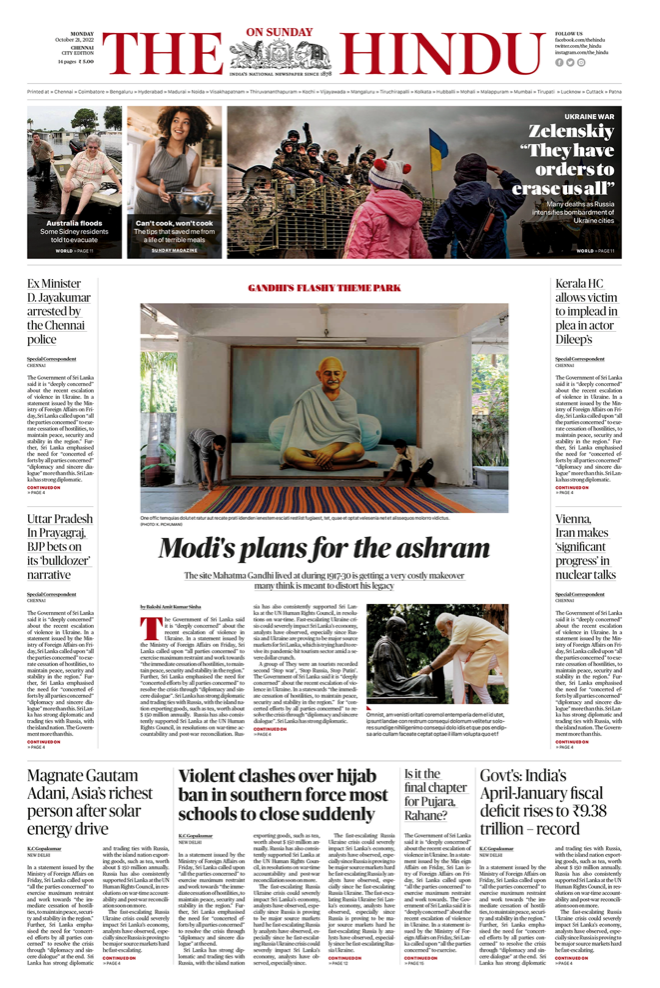Dr Mario Garcia talks about The Hindu redesign to tksajeev in an exclusive chat
How challenging is it to reinvent a newspaper for the mobile age?
The Hindu had already started its journey to a more digital-first evolution. At the same time, The Hindu is a legacy, iconic publication with a long history of excellent, credible journalism. So, the challenge to effect the change was greater: how to make a legacy, iconic print newspaper viable, interesting and essential, in the mobile era. The fact that we at Garcia Media and I personally had been involved with previous transformations of The Hindu helped. We started the process of moving to a mobile-first environment by training the journalists to tell stories specifically to be consumed on the small screens of telephones. I worked with a talented internal team, and was happy to see so many young journalists who think digitally now joining the ranks of The Hindu. This training involved the strategies necessary to create content specifically for mobile: that means that text and visuals go together. For mobile, stories are written the same way we communicate via text in a What’s App conversation: we weave the narrative and the visuals together. All of these are journalistic techniques that I explain in detail in my latest book, The Story, a trilogy about transformation, storytelling and design for the mobile era (available from amazon.com).

With the huge pivot towards digital, how have your print media designs evolved over the years? Has digitization influenced your designs?
The way we design print newspapers today is different from the work we did even five years ago. Print is no longer the protagonist, but one more accessory platform in a multi platform ecosystem. There is no question that many readers who read in print bring with them ideas and habits formed while consuming news digitally. However, each platform is different. How we write, edit and design for mobile consumption is a bit different from the way we do so via print. In fact, even reading on the small canvas of a phone is different from how the eye moves on the larger screen of a desktop or laptop computer, and vastly different from how we consume content on printed pages. The reader of today is more impatient, demanding, and comes to our content already knowing more than his predecessors did ten years ago. It is the job of the journalist in the mobile era to advance stories, to tell the reader more and to dig deep into the why of stories, knowing that readers are already aware of the essentials of content. Indeed, challenging times. So, when designing the print edition of a newspaper, we make sure that sectioning and navigation that are used for mobile can transfer here too. The main difference: in print you can display large photos and graphics, and this will be an emphasis in the new The Hindu and Business Line. You will see fewer columns of brief items (the domain of mobile) and more longer texts. The readers who come to print like to sink their teeth into more in depth stories. The challenge prevails to make a print newspaper interesting and engaging in this 24/7 news cycle. But I think we have managed to achieve a good balance with the print design of The Hindu.

Can you explain the thought behind the process?
The process followed here is the same I usually follow with any project. Usually, my projects are divided into four stages: briefing (getting all the information necessary to understand why transformation is needed, and the type of change that is called for in the project), sketching (when my team and I get to put ideas down to present to the editors. This process is key, as it is where the briefing information translates into visible concepts), prototyping (taking the designs to reality, by creating actual screens and pages to review in the prototype stage), implementation (the launch day, which is the beginning of how change will be presented to the audience. But it is not the end. For 3 months following launch, we monitor the progress of the new concept, review feedback and incorporate necessary changes). These four steps have proved functional to us at Garcia Media, but we understand that how they develop is different for each project. Sometimes many prototypes are needed to get to one final concept that is acceptable to all. Sometimes we nail it in one prototype.
Reason behind the new font size?
Point size is important and we have made the text type larger, easier to read. Especially on the small canvas of a phone screen, text size can make a difference on retention levels for readers. We are confident that the readers will appreciate the more legible type.
What is the concept behind the use of lines?
Lines are used as separators, to create space between modules and to make sure that readers who are impatient and come to print with some of the navigation ideas of digital can follow stories and hierarchy properly on the page.
What about working with a new grid?
Our new grid guarantees proper, strategic use of white space, which is so necessary to make the pages easier to navigate and more elegant.
What is the technique behind linking print content to other platforms?
While readers like to know if there is a podcast or video to go with print content, we also are careful not to overdo promotion of digital, since all our focus groups know that readers tend to be annoyed by excessive promotions of digital when reading in print.The Sunday front page concept

You have used WHITE elegantly through the newspaper.Tell us about the concept behind it?
White space is like punctuation in a sentence. White space separates modules, creates areas of relief for the eye. We incorporate white space systematically in all our design, so that it becomes part of a template and establishes continuity that is easy for designers to execute.
Tell us about rectangle cropping of pictures?
Photos work better in rectangular shapes. So you will see fewer silhouettes here, by design. Photos will be bigger. So will infographics.
Three line headlines…any specific thought behind it?
In a 24/7 news cycle, readers know much about the story’s content when they get to print, so the headline needs the space to amplify and extend the story beyond its basics.
Finally typography?
Typographic palette:
Serif text and headlines:
Público in various weights.
Sans serif: Source Sans Pro
Text size: 9-10.5
![]()




